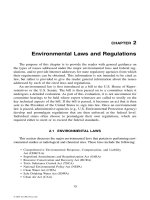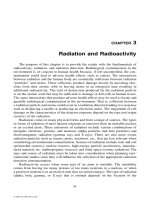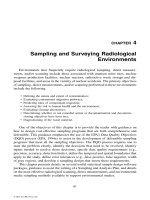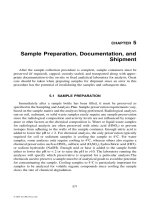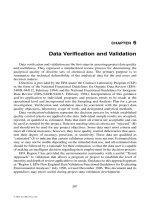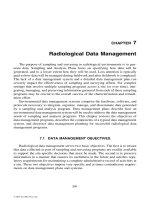SAMPLING AND SURVEYING RADIOLOGICAL ENVIRONMENTS - CHAPTER 5 ppt
Bạn đang xem bản rút gọn của tài liệu. Xem và tải ngay bản đầy đủ của tài liệu tại đây (212.89 KB, 15 trang )
271
CHAPTER
5
Sample Preparation, Documentation, and
Shipment
After the sample collection procedure is complete, sample containers must be
preserved (if required), capped, custody-sealed, and transported along with appro-
priate documentation to the on-site or fixed analytical laboratory for analysis. Great
care should be taken when preparing samples for shipment since an error in this
procedure has the potential of invalidating the samples and subsequent data.
5.1 SAMPLE PREPARATION
Immediately after a sample bottle has been filled, it must be preserved as
specified in the Sampling and Analysis Plan. Sample preservation requirements vary,
based on the sample matrix and the analyses being performed. Radiological analyses
run on soil, sediment, or solid waste samples rarely require any sample preservation
since the radiological composition and activity levels are not influenced by temper-
ature or other factors as the chemical composition is. Water or liquid waste samples
for radiological analysis are often preserved with nitric acid (HNO
3
) to prevent
isotopes from adhering to the walls of the sample container. Enough nitric acid is
added to lower the pH to < 2. For chemical analysis, the only preservation typically
required for soil or sediment samples is cooling the sample to 4°C. For water
samples, some analyses only require cooling to 4°C, whereas others also require a
chemical preservative such as HNO
3
, sulfuric acid (H
2
SO
4
), hydrochloric acid (HCl),
or sodium hydroxide (NaOH). Enough acid or base is added to the sample bottle
either to lower the pH to < 2 or to raise the pH to >10. The laboratory running the
analyses will specify which preservative is required for a particular analysis.The
chemicals used to preserve a sample must be of analytical grade to avoid the potential
for contaminating the sample. Cooling samples to 4°C is particularly important for
samples to be analyzed for volatile organic compounds since cooling the sample
slows the rate of chemical degradation.
© 2001 by CRC Press LLC
272 SAMPLING AND SURVEYING RADIOLOGICAL ENVIRONMENTS
To avoid any difficulties associated with adding chemical preservatives to sample
containers in the field, it is recommended that these preservatives be added to sample
bottles in a controlled setting prior to entering the field. This alternative reduces the
chances of improperly preserving sample bottles or introducing field contaminants
into a sample bottle while adding the preservative.
The preservative should be transferred from the chemical bottle to the sample
container using either a disposable polyethylene pipette or a standard glass pipette.
A glass eye dropper with rubber bulb is not recommended since the rubber has a
potential of introducing contaminants into the sample.
The disposable pipette is made of polyethylene, and should be used only once,
and then discarded. This pipette is more convenient than the standard glass pipette
method and provides the least opportunity for the cross-contamination of samples.
The standard glass pipette is preferred over the disposable pipette when bottles for
volatile organic analysis need to be preserved, since polyethylene has the potential
of providing trace volatile organics to the sample.
After a sample container has been filled, a Teflon-lined cap or lid is screwed
on tightly to prevent the container from leaking. The sample label is filled out,
noting the sampling time and date, sample identification number, sampling depth,
analyses to be performed, sampler’s initials, etc. (see Section 5.2.5). A custody seal
is then placed over the cap or lid just prior to placing the sample bottle into the
sample cooler. The custody seal is used to detect any tampering with the sample
prior to analysis.
5.2 DOCUMENTATION
Accurate documentation is essential for the success of a sampling program. It
is only through documentation that a sample can be tied into a particular sampling
time, date, location, and depth. Consequently, field logbooks must be kept by every
member of the field team, and should be used to record information ranging from
weather conditions to the time the driller stubbed his right toe. To assist the docu-
mentation effort, standardized forms are commonly used to outline the information
that needs to be collected. Some of the more commonly used forms include:
• Scanning instrument quality control check form
• Borehole log forms
• Well completion forms
• Well development forms
• Well purging/sampling forms
• Water level measurement forms
Other documentation needs associated with sample identification and shipment
include:
• Sample labels
• Chain-of-custody forms
© 2001 by CRC Press LLC
SAMPLE PREPARATION, DOCUMENTATION, AND SHIPMENT 273
• Custody seals
• Shipping airbills
In addition to the above documentation requirements, a careful file must be kept
to track important information, such as:
• Field variances
• Equipment shipping invoices
• Sample bottle lot numbers
• Documented purity specifications for preservatives, distilled water, and calibration
standards
• Instrument serial numbers
• Copies of shipping paperwork
• Quality assurance nonconformance notices
5.2.1 Field Logbooks
Field logbooks are intended to provide sufficient data and observations to enable
participants to reconstruct events that occurred during projects and to refresh the
memory of the field personnel if called upon to give testimony during legal pro-
ceedings. In a legal proceeding, logbooks are admissible as evidence, and conse-
quently must be factual, detailed, and objective.
Field logbooks must be permanently bound, the pages must be numbered, and
all entries must be written with permanent ink, signed, and dated. If an error is made
in the logbook, corrections can be made by the person who made the entry. A
correction is made by crossing out the error with a single line, so as not to obliterate
the original entry, and then entering the correct information. All corrections must
be initialed and dated.
Observations or measurements that are taken in an area where the logbook may
be contaminated can be recorded in a separate bound and numbered logbook before
being transferred into the master field notebook. All logbooks must be kept on file
as permanent records, even if they are illegible or contain inaccuracies that require
a replacement document.
The first page of the logbook should be used as a Table of Contents to facilitate
the location of pertinent data. As the logbook is being completed, the page numbers
where important events can be found should be recorded. The very next page should
begin recording daily events. The first daily event entry should always be the date,
followed by a detailed description of the weather conditions. All of the following
entries should begin with the time that the entry was made. Any space remaining
on the last line of the entry should be lined out to prevent additional information
being added in the future. At the end of the day, any unused space between the last
entry and the bottom of the page should be lined out, signed, and dated, to prevent
additional entries being made at a later date.
To assure that a comprehensive record of all important events is recorded, each
team member should keep a daily log. The field manager’s logbook should record
information at the project level, such as:
© 2001 by CRC Press LLC
274 SAMPLING AND SURVEYING RADIOLOGICAL ENVIRONMENTS
• Time when team members, subcontractors, and the client arrive or leave the site;
• Names and company affiliation of all people who visit the site;
• Summary of all discussions and agreements made with team members, subcon-
tractors, and the client;
• Summary of all telephone conversations;
• Detailed explanations of any deviations from the sampling and analysis plan, noting
who gave the authorization, and what paperwork was completed to document the
change;
• Detailed description of any mechanical problem that occurred at the site, noting
when and how it occurred, and how it is being addressed;
• Detailed description of any accidents that occurred, noting who received the injury,
how it occurred, how serious the injury was, how the person was treated, and who
was notified;
• Other general information such as when and how equipment was decontaminated,
what boreholes were drilled, and what samples were collected that day.
The team member’s logbook should record information more at the task level.
Examples of the types of information that should be recorded in these logbooks
include:
• Time when radiological surveys began and ended on a particular site;
• Details on the instruments used to collect radiological measurements;
• Results from instrument calibration checks;
• Details on remedial activities performed at the site;
• Radiological measurement data;
• Level of personal protective equipment used at the site;
• Sample collection times for all samples collected;
• Total depth of any boreholes drilled;
• Detailed description of materials used to build monitoring wells, including type of
casing material used; screen slot size; length of screen; screened interval; brand
name, lot number, and size of sand used for the sand pack; brand name, lot number,
and size of bentonite pellets used for the bentonite seal; brand name and lot number
of bentonite powder and cement used for grout; well identification number;
• Details on when, how, and where equipment was decontaminated, and what was
done with the wastewater;
• Description of any mechanical problems that occurred at the site, noting when and
how it occurred, and how it was addressed;
• Summary of all discussions and agreements made with other team members,
subcontractors, and the client;
• Summary of all telephone conversations;
• Detailed description of any accidents that occur, noting who received the injury,
how it occurred, how serious the injury was, how the person was treated, and who
was notified.
It is essential that field team members record as much information as possible
in their logbooks, since this generates a written record of the project. Years after the
project is over, these notebooks will be the only means of reconstructing events that
occurred. With each team member recording information, it is not uncommon for
one member to record information that another member missed.
© 2001 by CRC Press LLC
SAMPLE PREPARATION, DOCUMENTATION, AND SHIPMENT 275
5.2.2 Photographic Logbook
A photographic logbook should be used to record all photographs taken at a site.
This log should record the date, time, subject, frame, roll number (or disk number
for a digital camera), and the name of the photographer. For “instant photos,” the
date, time, subject, and name of the photographer should be recorded directly on
the developed picture. Clear photographs of field activities can be very useful in
reconciling any later discrepancies.
5.2.3 Field Sampling Forms
It is recommended that standardized field sampling/measurement forms be used
to assist the sampler in a number of field activities. Some commonly used forms
are presented in Figures 5.1 through 5.6. Forms are most often used to reduce the
amount of documentation required in the field logbook. Forms are also effective in
reminding the sampler of what information needs to be collected, and they make it
more obvious when the necessary information was not collected.
When forms are used, they should be permanently bound in a notebook, the
pages should be numbered, and all entries must be written with permanent ink. If
an error is made in the notebook, corrections can be made by the person who made
the entry. A correction is made by crossing out the error with a single line so as not
to obliterate the original entry and then entering the correct information. All correc-
tions must be initialed and dated. The person who completed the form should sign
and date the form at the bottom of the page. It is recommended that the field manager
also sign the form to confirm that it is complete and accurate.
5.2.4 Identification and Shipping Documentation
The essential documents for sample identification and shipment include the
sample label, custody seal, chain-of-custody form, shipping manifest, and shipping
airbill. Together, these documents allow radioactive samples to be shipped and/or
transported to an analytical laboratory under custody. If custody seals are broken
when the laboratory receives the samples, the assumption must be made that the
samples were tampered with during shipment. Consequently, the samples may need
to be collected over again. When shipping radioactive samples off site, it is essential
that 49 CFR 170 through 180 requirements for shipping container inspection and
surveying be carefully observed. If shipping radioactive samples by air, the require-
ments provided in the International Air Transportation Association (IATA), Danger-
ous Goods Regulations, must be followed.
Before shipment, and upon receipt of a radioactive shipment, a visual inspection
of packages should be performed to ensure that packages are not damaged. Prior to
shipment, gross alpha and gross beta/gamma measurements should be collected from
the outside surfaces of the individual sample containers and the shipping container
and the results recorded on the shipping paperwork. Care should be taken prior to
shipping multiphased radioactive samples, as settling of hot particulate or layering
may occur, resulting in an increase in the radiation levels that are measured for the
© 2001 by CRC Press LLC
276 SAMPLING AND SURVEYING RADIOLOGICAL ENVIRONMENTS
container. The radiation levels should be measured after settling has occurred and
the highest value used for preparing the shipment. When the shipping container is
received by the laboratory, gross alpha and gross beta/gamma measurements should
once again be collected from the outside surfaces of the shipping container and
should be compared against the readings reported on the shipping papers. This
practice ensures accountability. Any differences should be reconciled prior to accept-
ing the sample shipment.
Figure 5.1 Example of scanning instrument quality control check form.
© 2001 by CRC Press LLC
SAMPLE PREPARATION, DOCUMENTATION, AND SHIPMENT 277
Drivers of motor vehicles transporting radioactive samples should have a copy
of their emergency response plan or the emergency response information with them
as required by 49 CFR 172.600.
Figure 5.2 Example of a borehole log form used to record borehole lithology.
© 2001 by CRC Press LLC
278 SAMPLING AND SURVEYING RADIOLOGICAL ENVIRONMENTS
5.2.5 Sample Labels
The primary objective of the sample label is to link a sample bottle to a sample
number, sampling date and time, and analyses to be performed. The sample label
in combination with the chain-of-custody form is used to inform the laboratory what
the sample is to be analyzed for. At a minimum, a sample label should contain the
following information (Figure 5.7):
• Sample identification number
• Sampling time and date
Figure 5.3 Example of a well completion form.
© 2001 by CRC Press LLC
SAMPLE PREPARATION, DOCUMENTATION, AND SHIPMENT 279
• Analyses to be performed
• Preservatives used
• Sampler’s initials
• Name of the company collecting the sample
• Name and address of the laboratory performing the analysis.
To save time in the field, and to avoid the potential for errors, all of the above
information should be added to the sample label before going into the field, with
the exception of the sampling time and date, and sampler’s initials. This information
Figure 5.4 Example of a well development form.
© 2001 by CRC Press LLC
280 SAMPLING AND SURVEYING RADIOLOGICAL ENVIRONMENTS
should be added to the label following the capping of the sample bottle, immediately
after sample collection, and should reflect the time that sampling began, as opposed
to the time sampling was completed.
An effective sample numbering system is a key component of any field sampling
program since it serves to tie the sample to its sampling location. The problem with
using a simple numbering system such as 1, 2, 3, … is that the number tells you
nothing regarding the location, depth, or sample media.
The number of digits used in a sample numbering scheme should be discussed
with the laboratory performing the analyses since it may have limitations on the
Figure 5.5 Example of a well purging and sampling form.
© 2001 by CRC Press LLC
SAMPLE PREPARATION, DOCUMENTATION, AND SHIPMENT 281
number of digits used in a sample number. If only six digits are available, an effective
numbering system can be developed with a little imagination. As an example, assume
that a project has a total of nine buildings where swipe, paint, dust, concrete, and
shallow soil samples are to be collected. In this example, each of the six sample
number digits could be used to represent the following:
First digit: Site Number (1, 2, 3, … 9)
1 = 103-R Reactor Building
2 = 106-D Biological Laboratory
Figure 5.6 Example of water level measurement form.
© 2001 by CRC Press LLC
282 SAMPLING AND SURVEYING RADIOLOGICAL ENVIRONMENTS
3 = 110-A Pump House
4 = 121-L Treatment Plant
5 = 158-A Testing Laboratory
6 = 185-B Pump House
7 = 205-D Storage Building
8 = 242-S Reactor Building
9 = 251-D Transfer Station
Second digit: Media Number (1, 2, 3, … 5)
1 = swipe
2 = paint
3 = dust
4 = concrete
5 = shallow soil
Third, fourth, and fifth digits: Sampling Location Number
S99 = swipe (1,2,3,. . .99)
P99 = paint (1, 2, 3,. . .99)
D99 = dust (1, 2, 3,. . .99)
C99 = corehole (1, 2, 3,. . .99)
B99 = borehole (1, 2, 3,. . .99)
Sixth digit: Sample number
1 = first sampling interval
Figure 5.7 Example of sample label and custody seal.
© 2001 by CRC Press LLC
SAMPLE PREPARATION, DOCUMENTATION, AND SHIPMENT 283
2 = second sampling interval
3 = third sampling interval
4 = fourth sampling interval
5 = fifth sampling interval
6 = sixth sampling interval
7 = seventh sampling interval
8 = eighth sampling interval
9 = ninth sampling interval
The sample number “85B032” would therefore indicate that the sample was
collected from the 242-S Reactor Building, it is a shallow soil sample, it was
collected from Borehole No. 3, and it was collected from the second sampling
interval. When using both numbers and letters in a sample number, one should try
to minimize the use of letters such as S, l, and O, which can easily be misinterpreted
as the numbers 5, 1, and 0.
Some laboratories will allow sample numbers as long as 10 or 12 characters in
length. These additional characters should be taken advantage of, since the easier it
is to interpret the sample identification number, the easier it will be to interpret the
data reported by the laboratory.
5.2.6 Chain-of-Custody Forms and Seals
Chain-of-custody is the procedure used to document who has the responsibility
for ensuring the proper handling of a sample from the time it is collected to the time
the resulting analytical data are reported by the laboratory to the customer. After a
sample bottle has been filled, preserved, and labeled, a custody seal is signed and
dated, then placed over the bottle cap to assure that the sample is not tampered with
(see Figure 5.7). The custody seal is a fragile piece of tape designed to break if the
bottle cap is turned or tampered with.
The person who signs his or her name to the custody seal automatically assumes
ownership of the sample until the time it is packaged and custody is signed over to
the laboratory, carrier, or to an overnight mail service. This transfer of the custody
is recorded on a chain-of-custody form (Figure 5.8). The chain-of-custody form is
also the document used by the laboratory to identify which analyses to perform on
which samples. When the laboratory receives a sample shipment, it assumes custody
of the samples by signing the chain-of-custody form. The sample bottles in the
shipment are then counted, and the requested analyses on the sample bottles are
compared against the requested analyses on the chain-of-custody form. If there are
any inconsistencies, the laboratory should contact the project manager for clarifica-
tion. These communications should all be carefully documented.
An overnight shipping airbill can be used to document the transfer of custody
from the field to the mail service. If this option is selected, the shipper’s airbill
number should be recorded on the chain-of-custody form, which can be taped inside
the sample container. When the laboratory signs the shipper’s delivery form and
the chain-of-custody form inside the sample container, it has assumed custody of
the sample.
© 2001 by CRC Press LLC
284 SAMPLING AND SURVEYING RADIOLOGICAL ENVIRONMENTS
Figure 5.8 Example of a chain-of-custody record.
© 2001 by CRC Press LLC
SAMPLE PREPARATION, DOCUMENTATION, AND SHIPMENT 285
Although most analytical laboratories will dispose of chemically contaminated
samples once the analyses have been completed, they often return radiologically
contaminated samples to the customer, who must then assume responsibility for
disposal. Laboratories must be licensed by the Nuclear Regulatory Commission
and/or state to receive and handle radioactive materials. The license specifies the
maximum quantity of radioactive material that the laboratory can receive and store.
5.2.7 Other Important Documentation
Careful documentation should also be maintained for all incoming shipments of
materials and supplies used to support sampling activities. The most critical docu-
ments to keep on file include:
• Shipping invoices
• Sample bottle lot numbers
• Purity specification for preservatives, distilled water, and calibration liquids and gases
• Instrument serial numbers and calibration logs.
Copies of shipping invoices can be used by the project manager to keep track
of equipment costs, and can expedite the return of malfunctioning equipment. It is
critical to keep track of sample bottle lot numbers and purity specifications for all
chemicals used, since improperly decontaminated bottles and low-quality preserva-
tion of decontamination chemicals can contaminate samples. Instrument serial num-
bers are recorded to assist in tracking which instruments are working well, and which
must undergo repair.
REFERENCES
49 CFR 173, Shippers—General Requirements for Shipments and Packagings, Code of
Federal Regulations (as amended).
DOE (U.S. Department of Energy), Radiological Control Manual, Chapter 4—Radioactive
Materials. Part 2—Release and Transportation of Radioactive Material, DOE/EH-0256T,
Article 423, April, 1994.
EPA (Environmental Protection Agency), Guidance on Remedial Investigations under CER-
CLA, EPA/540/G-85/002, 1985, 4–2, 4–4.
EPA (Environmental Protection Agency), A Compendium of Superfund Field Operations
Methods, EPA/540/P-87/001a, 1987, 4–13.
EPA (Environmental Protection Agency), RCRA Facility Investigation (RFI) Guidance, PB89-
200299, 1989.
IATA (International Air Transportation Association), Dangerous Goods Regulations.
© 2001 by CRC Press LLC




